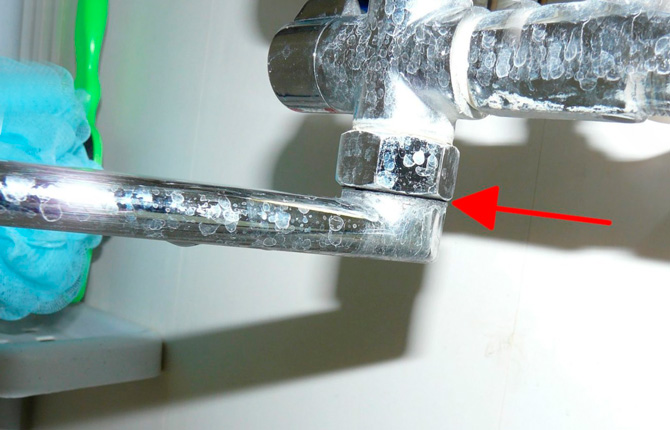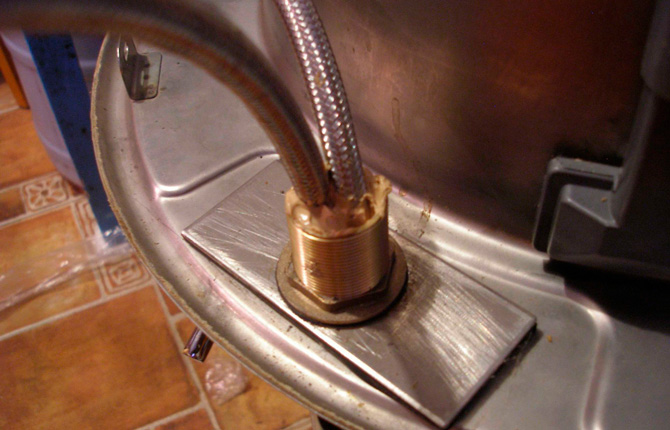How to easily unscrew the nut on a faucet - proven methods
In a humid environment, the metal begins to corrode, causing the mixer to fail.It needs to be repaired or replaced with a new one. This means that it must be disassembled or dismantled. That is, you will have to remove the fasteners in any case, which means the question arises of how to unscrew the nut on the mixer.
The content of the article:
Mixer device
There are several nuts on the mixer that can be unscrewed:
- one attaches the gander to the body of the plumbing fixture;
- the second, called the clamping one, holds the faucet itself on the sink or sink;
- Two nuts on the shower mixer secure it to the hot and cold water pipes.
There is also a way fastenings the appliance to the sink or sink using two nuts located below.
All of them are exposed to the negative effects of moisture and oxygen, which means they “stick” so that it will be difficult to unscrew them. Therefore, you will need to deal with each option separately.
Preparation and necessary tools
First of all, you need to shut off the water line on which the mixer sits. To do this, close the tap or valve.
The second stage of preparation is to select a tool for the plumbing operation. In most cases, you won’t be able to get by with just one device. Typically, in order to unscrew a rusted nut, you need:
- wrench - adjustable or gas, cap, open-end, socket;
- screwdrivers;
- pliers;
- metal brush;
- hammer.
Read the article: The best hammers of 2023.
Methods and repair work
It is necessary to indicate that different mixers are located on different surfaces. And some fasteners are not visible.Sometimes it can be difficult to get them, which complicates the entire unscrewing process. Therefore, each situation must be analyzed separately.
Nut holding the jib
This is the simplest fastening element located on the top of the mixer structure. With its help, the spout, also known as the gander, is held on the body of the device. Its other purpose is to press the sealing collar to make the connection airtight.
If water begins to seep in, this indicates that the seal has been broken. The reason is gasket wear. The nut can be tightened a little. If the problem is not solved, then the cuff needs to be changed. And to do this you will have to unscrew the nut. The same applies to the situation when the spout stops rotating around its axis.
The problem is solved quite simply:
- The nut is wrapped in cloth.
- They hook it with pliers.
- Turn counterclockwise.
Usually a small amount of force is enough to overcome the resistance of the part. Instead of pliers, you can use an adjustable or open-end wrench.
The fabric is used for one purpose - pliers leave teeth marks on the nickel-plated surface, because they must be pressed with force. The fabric will act as a barrier to prevent these marks from forming. In this regard, the wrench is a more gentle tool, but even here, before unscrewing the nut, it is better to lay the gasket.

Clamp nut
It is located under the sink or sink, which complicates the whole process. Therefore, before unscrewing the rusty nut under the mixer, you need to decide how to do it. You can use two options:
- Get under the plumbing fixture and try to unscrew the clamping nut.
- Remove the sink or sink, turn it over and unscrew the part.
The first option is complicated by the fact that there is not enough space under the device, and it is not easy to find the nut by touch and use the tool. It is not a fact that the key will fit in a limited space. Especially if you need to additionally attach an extension cord in the form of a tube to it.
Therefore, option number two, although more labor-intensive, is simpler. Removing a sink or sink is not as difficult as it might seem. To do this, two underwater hoses for hot and cold water are unscrewed from the pipes of the water supply system, and not from the mixer.
Usually the plumbing fixture just lies on the cabinet. The only fastening is silicone sealant around the perimeter. Therefore, it will not be difficult to dismantle it. There is an option when the bathroom sink is attached to the wall with two bolts. They can also be unscrewed and the bowl removed.
After that, the plumbing fixtures are laid upside down on the table or floor so that the clamping nut is clearly visible and has easy access to it.
Before unscrewing a rusty nut, you first need to determine how stuck the part is. Usually this is a bronze or brass element that is not afraid of corrosion. Therefore, she could not get too attached. Therefore, the easiest way is to pick up a spanner wrench, put it on the nut and turn it counterclockwise.
If it doesn't work out the first time, don't put in much effort. It is better to moisten the connection with water, wait 15-20 minutes and try to unscrew it again. Usually this is where the problem ends.
If that doesn’t work, you can lightly tap the fastening with a hammer. In this way, the rust that holds the parts together is destroyed.
If this does not help to unscrew the nut, then you will need a liquid that penetrates the corroded area and softens it. Such liquids include kerosene or gasoline. There is a special composition called WD-40. It is sold in auto parts stores. The liquid is simply applied:
- the cap is removed;
- put the tube that comes with the kit over the hole;
- press the button at the top;
- liquid pours out of the tube in the form of an aerosol.
The composition is active, so the entire operation must be carried out in protective gloves and try not to inhale the vapors.
Leave the nut in this form for half an hour, after which it can be easily unscrewed using an adjustable wrench.

Fastening nuts
There are a variety of faucets that are attached to the sink or sink with special bolted connections. These are one or two pins, one end of which is screwed into the mixer itself.
This is carried out in the factory. The opposite ends remain free. They are the ones that are inserted into the mounting holes in the plumbing fixture, and the nuts are screwed onto them. This is clearly visible in the photo below.

Like any fasteners, these “stick” to each other so that they are difficult to unscrew. Small nuts are installed here, so it is better to use an open-end wrench or a spanner. The latter captures six edges of the head at once, which simplifies the unscrewing process.
As in all other options, a hammer, special liquids and other methods are also used here.
Fastening connections of this type are considered the most capricious. The studs do not always withstand the torque from the key, so they break across. If this happens, you will have to change the mixer.
This is the only place where you can use grinder. Often the nuts cannot be unscrewed and the mixer cannot be dismantled. There is only one thing left to do - cut off the fasteners. And it can’t be done better or faster than with a grinder.
Recommendations
There are many tips from experienced plumbers that you can use. One of them concerns the question of how to unscrew the nut on a faucet without a key. To do this, the device must be immersed in water into which citric acid was previously poured. For 1 liter of water, 1 tablespoon of acid.
The solution is active. It penetrates into all joints, destroying rust. A day in the solution, and the mixer can be disassembled into parts manually.
Other useful tips:
- If you put lubricant under all the nuts, you can unscrew them in the future without effort or hassle.
- The better the material from which the mixer is made, the longer it will last, and the easier it is to disassemble it.
- If the edges of the nut have been “knocked down”, then you can unscrew it with a special socket head called “Super Lok”. It increases the force of promotion by 20-30%. In this case, the nut does not deform.
- Safety precautions are not only compliance with the rules of operations, but also a technically sound instrument.
- You should not use technologies involving open fire to unscrew bolted joints. Especially if the process is carried out inside the house.
A few years after using the mixers, they must be repaired or replaced with new ones. This is where problems arise with all kinds of fastenings. It is possible to cope with such a problem, but it does not always work out. It all depends on the degree of “sticking” of the threaded joints. You can use the methods described above. But they do not always lead to 100% success.
If you have any questions, ask them in the comments. If you liked the article, share it on social networks and save it in your bookmarks.
We also recommend watching a selection of videos that will reinforce your knowledge and answer any remaining questions.
How and with what to unscrew a rusty nut on a faucet.

How to disassemble a kitchen faucet - repairing an old kitchen faucet, in detail, step by step.

Sources:
- https://stroy-podskazka.ru/vannaya/smesiteli/otkrutit-gajku
- https://setafi.com/vanna/smesitel/kak-otkrutit-prikipevshuyu-gajku-na-smesitele




The clamping nut on the mixer, if it is rusty, and if you do not remove the sink, cannot be unscrewed. The plumbing will have to be dismantled. It's a lot of fuss, but it's better this way.
If you’re stuck, sometimes even a Vedashka won’t help. I tried it once with a chisel and hammer. Nothing worked, the mixer broke. Almost damaged the sink.
If the faucet has been standing for 10 years like mine, then you won’t be able to unscrew the clamping nut with anything!! I sawed... completely removed the shell and had to dodge and saw the nut. until she weakened.
Well, what kind of advice is this for unscrewing the clamping nut: if the first method doesn’t work, use the second?